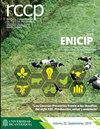Increasing levels of Chlorella spp. on in vitro fermentation and methane production in a corn silage-base diet
IF 0.2
4区 农林科学
Q4 AGRICULTURE, DAIRY & ANIMAL SCIENCE
引用次数: 0
Abstract
26 Background: Generally, forages used in cow-calf and backgrounding operations have low 27 crude protein and high fiber concentration, limiting animal performance and increasing 28 greenhouse gas emissions. Chlorella spp., a green micro-algae, shows promising attributes 29 to provide nutrients, especially nitrogen, in low-protein diets. However, information is 30 limited regarding the effects of Chlorella spp. on in vitro fermentation and methane (CH 4 ) 31 production. Objective: To evaluate the effects of increasing inclusion levels of algae 32 ( Chlorella spp.) on ruminal in vitro fermentation profile and CH 4 production in a corn silage-33 based diet. Methods: Incubations were conducted on three separate days using corn silage 34 and gin trash as substrate (70:30 ratio, respectively). Treatments were control (without algae), 35 and 1, 5, and 10% of algae inclusion in the substrate replacing basal diet. Ruminal fluid was 36 collected from two ruminally cannulated Angus crossbred steers fed ad libitum a corn silage 37 and gin trash diet. The final pH, the concentration of volatile fatty acids (VFA) and ammonia 38 nitrogen (NH 3 -N), in vitro organic matter digestibility (IVOMD), total gas, and CH 4 39 production were determined after 24 h of incubation. Variables were evaluated using the 40 MIXED procedure of software SAS, and means were compared using orthogonal polynomial 41 contrast. Results: Algae inclusion linearly increased (p<0.01) the IVOMD. However, the 42 final pH and concentration of VFA and NH 3 -N were not different (p>0.05) among the algae 43 levels. The molar proportion of VFA and the acetate:propionate ratio were not affected 44 (p>0.05) by increasing algae inclusion. Finally, total gas and CH 4 production were not 45 different (p>0.05) among treatments. Conclusions: The inclusion of Chlorella spp. did not提高玉米青贮基础日粮中小球藻体外发酵和甲烷产量的水平
背景:一般来说,犊牛和背景作业中使用的饲料粗蛋白质含量低,纤维含量高,限制了动物生产性能,增加了温室气体排放。小球藻(Chlorella spp.)是一种绿色微藻,显示出在低蛋白饮食中提供营养,尤其是氮的良好特性。然而,关于小球藻对体外发酵和甲烷(ch4) 31产生的影响的信息有限。目的:研究提高小球藻(Chlorella spp.)添加水平对玉米青贮-33型饲粮瘤胃体外发酵曲线和甲烷产量的影响。方法:以玉米青贮34和杜松子酒垃圾为基质(比例分别为70:30),孵育3 d。对照(不含藻类)、底物中添加35%、5%和10%的藻类替代基础饲粮。选取2头瘤胃空心安格斯杂交阉牛,随意饲喂玉米青贮饲料和杜松子酒垃圾饲料。培养24 h后测定终pH、挥发性脂肪酸(VFA)和氨氮(nh3 -N)浓度、体外有机物消化率(IVOMD)、总气量和ch439产量。采用SAS软件的40 MIXED程序评估变量,采用正交多项式41对比比较均值。结果:藻类含量随藻类含量的增加呈线性增加(p0.05)。添加海藻对VFA摩尔比和乙酸丙酸比无显著影响(p < 0.05)。不同处理间总气和甲烷产量差异不大于45 (p < 0.05)。结论:小球藻属未被纳入
本文章由计算机程序翻译,如有差异,请以英文原文为准。
求助全文
约1分钟内获得全文
求助全文
来源期刊

Revista Colombiana De Ciencias Pecuarias
AGRICULTURE, DAIRY & ANIMAL SCIENCE-
CiteScore
0.80
自引率
0.00%
发文量
18
审稿时长
6-12 weeks
期刊介绍:
The editors of Revista Colombiana de Ciencias Pecuarias (RCCP) welcome the submission of original manuscripts on experimental and clinical studies associated with the broad areas of animal sciences and veterinary medicine as they interface with biochemistry, molecular biology, physiology, pharmacology, toxicology, pathology, microbiology, parasitology, immunology and epidemiology. The scope of the journal includes studies of basic and applied research in animal management and production, feeding and nutrition, reproduction, breeding, genetics, animal welfare and behavior; as well as animal production focussed from biotechnology, soil science, agrostology, silvopastoral systems, livestock economics and the environment.
The criteria for acceptance of papers submitted for publication are originality, quality and clarity of the content. Each contribution must be based on original, unpublished research that has not been simultaneously submitted to other journals. All papers will be peer reviewed. All authors bear responsibility for ensuring the integrity and quality of their reported research. It is the author''s responsibility to secure permission to use figures or tables that have been published elsewhere.
Contributions may be classified as original research, review, rapid communication, clinical case studies or methodological articles, as well as news/commentaries or letters to the editor. Most review articles are invited by the editor. Authors interested in submitting a review article should contact the corresponding editor. Rapid publication of original manuscripts is a goal of the journal. Manuscripts must be written in English. Each manuscript is considered for publication with the understanding that it has not been simultaneously submitted to any other journal. Upon acceptance for publication, papers are subject to editorial review and revision.
 求助内容:
求助内容: 应助结果提醒方式:
应助结果提醒方式:


